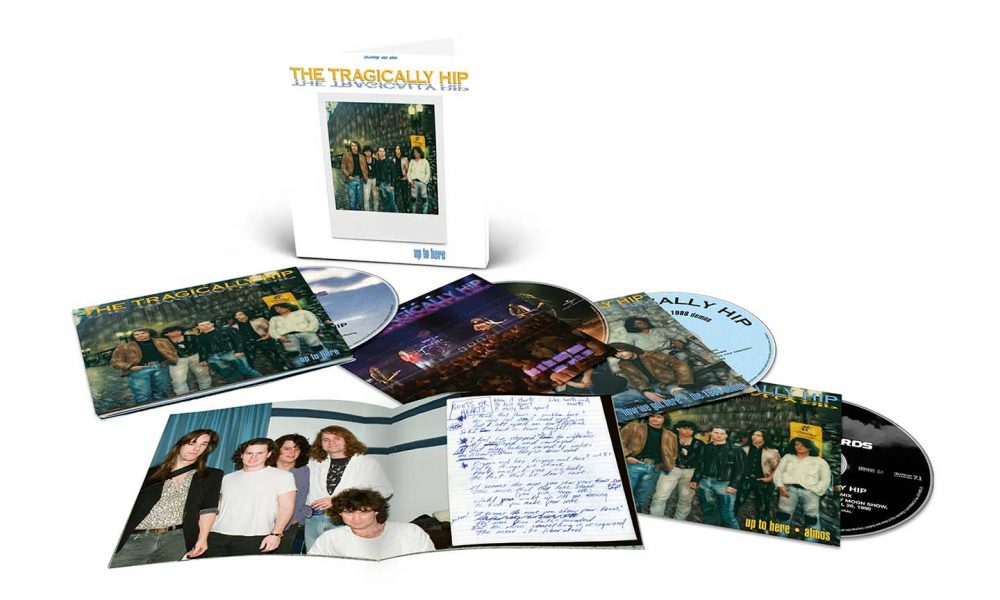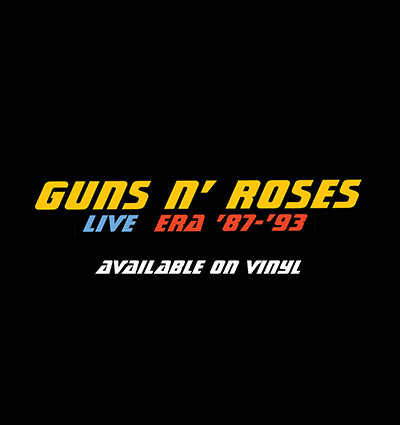Rob Baker Of The Tragically Hip: ”Up To Here’ Is The One That Really Brought Us To The Dance’
The Tragically Hip member talks us through the upcoming box set that celebrates the group’s debut album.

The Tragically Hip‘s debut album, Up To Here, is a landmark in Canadian music. Since its release in September 1989, it has sold over a million copies in Canada alone, making it one of the Top 40 selling albums in the band’s home country of all time. More than commercial success though, the songs on Up To Here – particularly singles “Blow At High Dough” and “New Orleans Is Sinking” – have become stitched in to the fabric of the nation; communal anthems that are still bringing people together today. The Tragically Hip – Rob Baker (guitar), Gord Downie (vocals), Johnny Fay (drums), Paul Langlois (guitar) and Gord Sinclair (bass) – went on to become one of the most beloved Canadian bands of all time, but Up To Here remains one of their most celebrated albums.
It represented a significant shift from the raw bar band rock of The Tragically Hip’s self-titled EP, released in 1987. Up To Here harnessed the EP’s sense of energy and purpose but – hardened by constant touring – they were that bit more powerful, while the whole band’s songwriting had flourished, and frontman Gord Downie developed a unique and charismatic persona that set The Tragically Hip apart from their contemporaries.
The tragic death of Downie in October 2017 brought the curtain down on The Tragically Hip, but in recent years the band have worked together on deluxe reissues of their catalogue. Now it’s the turn of Up To Here, so uDiscover spoke to Rob Baker about looking back on the band’s early years, their time recording Up To Here in the legendary Ardent Studios, Memphis, and the lasting impact of The Tragically Hip’s music.
How does it feel to revisit the music you made as such a young band on this Up To Here deluxe edition?
It’s a lot of time looking in the rearview mirror, which is something we never did as a band. It was always about plowing forward. There’s a lot less of that these days! Up To Here, on some level is the big enchilada for us. It’s the one that really brought us to the dance.
I don’t spend a lot of time listening to our old records. We recorded them, played those songs every night for years and then certain songs would carry on and have a life of their own. But I never really stopped to go back and listen. So it’s been a joy to do that. And then also to go through the memories of how we got there – the recording sessions, the people involved and some of the shenanigans involved. It’s a good trip down memory lane.
Can you tell us more about what’s in the deluxe set?
The album is remastered and there’s also the Dolby Atmos mix. Then with each of these rereleases, we’ve been adding a live album from the time period. And the one we chose here was a show that we played in Halifax in 1990 at a place called the Misty Moon. We were a young band and playing to 1,000 people – that feels pretty good for a young band. The whole thing was filmed for MuchMusic, which was kind of Canada’s MTV. We were lucky that we put on a great show and found the tapes. It was all done on multitrack, so we’ve been able to restore that.
Then there’s an album of songs that we’d demoed and recorded before going into Memphis to make the record – a couple which didn’t make the final album. I always felt like my two favourite songs were left off of every record. We would go into the studio with 17 songs, usually whittle that down to 15, do full work-ups and then try and cut them down to 11 or 12. So there were always good songs left over. It’s not so much a matter of quality as maybe we’ve got too many songs of one tempo. Or that’s four songs in the key of A or whatever. It’s usually a mundane reason why the song doesn’t make it onto an album.
A prime example of that is “Get Back Again,” which never made an album but became a fan favorite thanks to early live versions. How did a song of that quality get left off the record?
There was something about that song that I personally felt like, “Oh, this is the first song we’ve written that feels like serious songwriting rather than just something to get people shaking their asses.” We demoed it in a studio in Toronto and while we were recording it, I looked over at Gord Sinclair and he looked at me, about a minute into the song. It was like, there’s real magic happening here. The sounds were perfect, the playing was spot on. When the last note rang out, we all broke into fits of laughter because it was just, that was it, that was the one. And then we got the call from the control room, “One more time like that guys, and we’ll turn on the recording.” And it kind of soured us on the song, we did another take [the version now released on the Up To Here deluxe edition], and I gotta say, it was really good, there’s not a damn thing wrong with it. But in our minds, it had been tainted.
Then when we got to Memphis, we did another version. And, again, it was fine. But I think at that point, we were just more charged up about the more recent songs we were writing. That’s something that is a common tale in the band – by the time you get into the studio, you’ve got 20 songs. And often, the first couple you wrote for the album are the ones that get shifted – not because they aren’t deserving, but because they’re older.
The demos on the new set are so raw and exciting, emphasizing the band’s punk influences. How does it feel listening back to them?
It had been a long time since I’d heard them. I’m always really pleasantly surprised and like, why can’t I play guitar like that anymore? You just play differently as you go along. Gord Sinclair and I came out of The Clash, The Jam and The Specials – that was our vibe. Johnny Fay was much more Split Endz and The Police and that stuff and Gord Downie was really about R.E.M. and The Replacements. And we all came together, there was common ground for all of us starting out and you hear it in the music, it was just thrash.
And how about the live footage of the show on the Blu-Ray?
It’s like going through baby photos. Going through the old family album, like, “Oh my God, look at the pants I’m wearing there. What was I thinking?” It’s fun. Gord Sinclair, our bass player. Now he looks a lot more like 70s era Clint Eastwood, but back then he had the full mop. It was incredible. And his hair was always out of time with his body – he’d bob forward, and his hair would be going back! It’s great, though I think it’s horrifying for him to look back at this stuff.
Playing live was obviously hugely important in the band’s development…
At that point, we were very much about the early-to-mid-60s London blues scene. You don’t go out and play stadium rock in a sweaty pub, you play sweaty pub music – The Yardbirds, the young Stones, Them or The Pretty Things. And that was just our model. It was not about so much about building up a repertoire of material, which we were doing, but it was more about trying to create a small scene that was our own that we could take around with us wherever we went and people would know, if you go there, it’s going to be hot and sweaty, and there’s going to be a lot of beer flowing.
The progression in those two years between the self-titled EP and Up To Here is impressive. How did that happen?
We felt like we were a success the first time we got together and wrote a song, and it sounded good. And then you’re demoing, then it’s a record and then you’re going away to Memphis to make a full-length album. It was all just one step at a time. Ultimately, it was about getting people to the shows, and the records were a calling card that let us tour. There were a few years where we were playing 250 shows a year – you just get better and you change. You don’t want to repeat what you’ve done. So you’re constantly trying to push that and you’re seeking out new influences.
There’s a point early on, you don’t even think about it, your influences just come shining through. And then it’s like, oh, we have to hide our influences a little bit. We don’t want to show that too much. I think it’s foolish – let it show, let it come through, as long as you’re not trying to sound like someone else. We just kept working on it on our own and playing shows and recording and writing, and eventually your own voice comes out.
What was it like to record Up To Here in Ardent Studios, following in the footsteps of Led Zeppelin, Al Green, R.E.M., The Allman Brothers and so many more?
It was super exciting, we were, and are, fans. I’ve always been about the search for the source of songs and ideas – where do they come from? Ardent isn’t the very beginning, but it’s certainly a mecca along the way.
We recorded the EP at a place in Toronto called Sounds Interchange, where Alice Cooper and Bob Seger had done a lot of stuff and that was exciting. We’re in a big, fancy, shiny studio, look at the size of the console. But to be in Memphis at Ardent was a whole other thing.
Memphis is a funny city. It has a ground buzz. It’s wired very badly with very old wiring. And if you’re playing a Stratocaster guitar through a tube amp, there’s just an undeniable, horrible buzz. It kind of tapers off after about six o’clock, but it’s still there. We were desperate, trying to figure out how to deal with this buzz. How did other bands make great records here? We went across town to Kiva Studios and Stevie Ray Vaughan was there. He showed us what he was doing to deal with the sound and so I ended up playing the whole record with a copper wire wrapped around my jack cord, which is wrapped around a spoon which is shoved down inside the sock inside my cowboy boots resting on my heel and that worked.
This is a tale I probably shouldn’t be telling out of school, but we had a night off and we’d had many beers. There was a storage closet in the studio’s control room where the 2” master tapes for the ZZ Top album Degüello were kept. So our engineer and producer put those tapes on, and they mixed Degüello in real time. It was pretty incredible, a great experience.
And there’s a marked progression in Gord’s lyrics on this album….
Absolutely, Gord was really coming into his own as a lyricist, then the next album, Road Apples, was all his lyrics. On Up To Here, we were still splitting songs – we’d made the decision to be a communist collective, to share all the credit and all the money. That will help keep the band together. We don’t want someone showing up in a Lamborghini and everyone else is taking the bus because that’s a recipe for a short-lived band. Everyone was an aspiring songwriter, and it helped us on that path. So on Up To Here, Paul Lanois wrote all the lyrics on a couple tunes, Gord Sinclair wrote the lyrics on a couple and the music was coming from four of us.
What were you aiming for in terms of the sound of the new remaster?
It sounds more like it sounded to us when we were doing it. The aim was to make it sound more present, more in your face. And when you hear the Atmos mixes, it’s kinda creepy. Gord is right there in front of you. You can close your eyes and we’re all right there spaced in front of you, the listener – you feel the space around you, it’s really interesting.
You were the art director of The Tragically Hip. How hands-on are you with these new releases?
I’m very hands on with the rereleases. I was the band liaison for the first couple of records. With Up To Here, as we were a young band and untested, the label didn’t give me a lot of leeway. It was like, here’s a guy we want to use for the cover. What do you think? After we’d had a couple of successes, they gave me the reins. It was the third album when I really put my stamp on things. Now I get to go back through the thing and design the package with Simon Evers, who works at Universal – he’s fantastic, we work very well together. He knows where I’m coming from now.
In Canada, these songs really have become part of the culture, how does that feel?
Sometimes I’ll hear our song on the radio and I feel quite removed from it in a weird way. Those songs have a life of their own. I always considered the recorded version to be the best we could make it sound at that moment in time. And then we went out and played it another 3,000 times and every time was different. Some of those songs stayed close to that freeze-dried version, the album version. And other songs like “Blow At High Dough” and particularly “New Orleans Is Sinking” – they continued to grow and change and stay interesting for us to play them.
And of course, Gord’s on-stage monologues during “New Orleans Is Sinking” became legendary…
Story time! We never knew what was coming and I don’t think he did either. He might have a rough idea of something he wanted to talk about, but often it was just extemporaneous. He would just let it fly, and we’d hang on for dear life. On stage, it was loud, you couldn’t always make out every word, so it was just about trying to take in the sweep of it. Is the story building in intensity or do we need a lull here? Just try and follow the dynamic and at the same time, that was the goal.
What makes you proudest about Up To Here, listening to it today?
What I really like about it – and it is something I’m proud of – is that we were a young band, we didn’t really know what the hell was going on. We went into the studio with Don Smith, a producer who we’d never met, but we were very excited about, because he’d worked with Keith Richards, Roy Orbison, Tom Petty, Bob Dylan. We thought, he’s really going to mold our sound. But he just loved our band, so he just wanted to capture the way we sounded. He didn’t want to shape us in any way. He just wanted to make it as us as he could make it. He didn’t want to interfere – I spent the first three or four days waiting for him to come and tell me how he wanted my amp tweaked or to switch guitars. But there was none of that, he wanted us to be us.
We set up like we were a live band. And we knocked the songs out like a live band with live vocals. There were overdubs done on some songs, but the bulk of it is just a live record. And it’s that thing with young bands – you spend a couple of years writing your first record, and you go in, you knock it off pretty quickly. And then it gets harder and harder as you go along. And you find yourself writing in the studio and everyone’s leading their own separate lives. At that time, we were all in one boat, and we’re all pulling on the oars together, with one common vision. And I think it comes through in the music – I think you can hear that.
Order the deluxe edition of The Tragically Hip’s Up To Here now.














